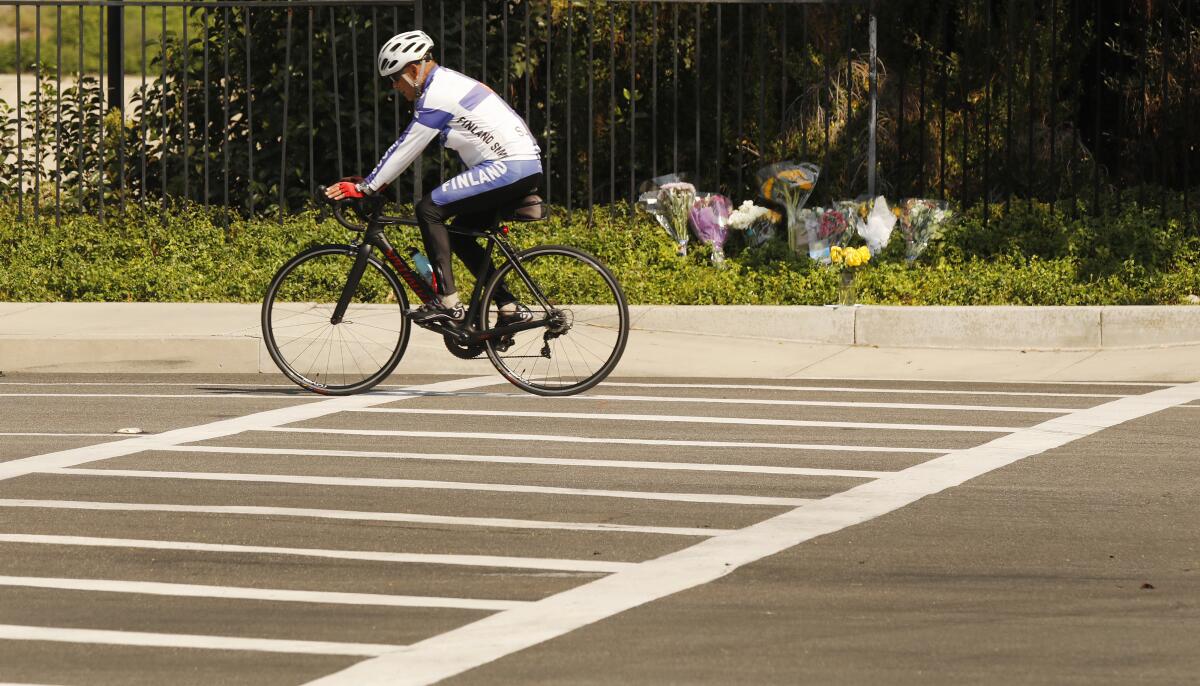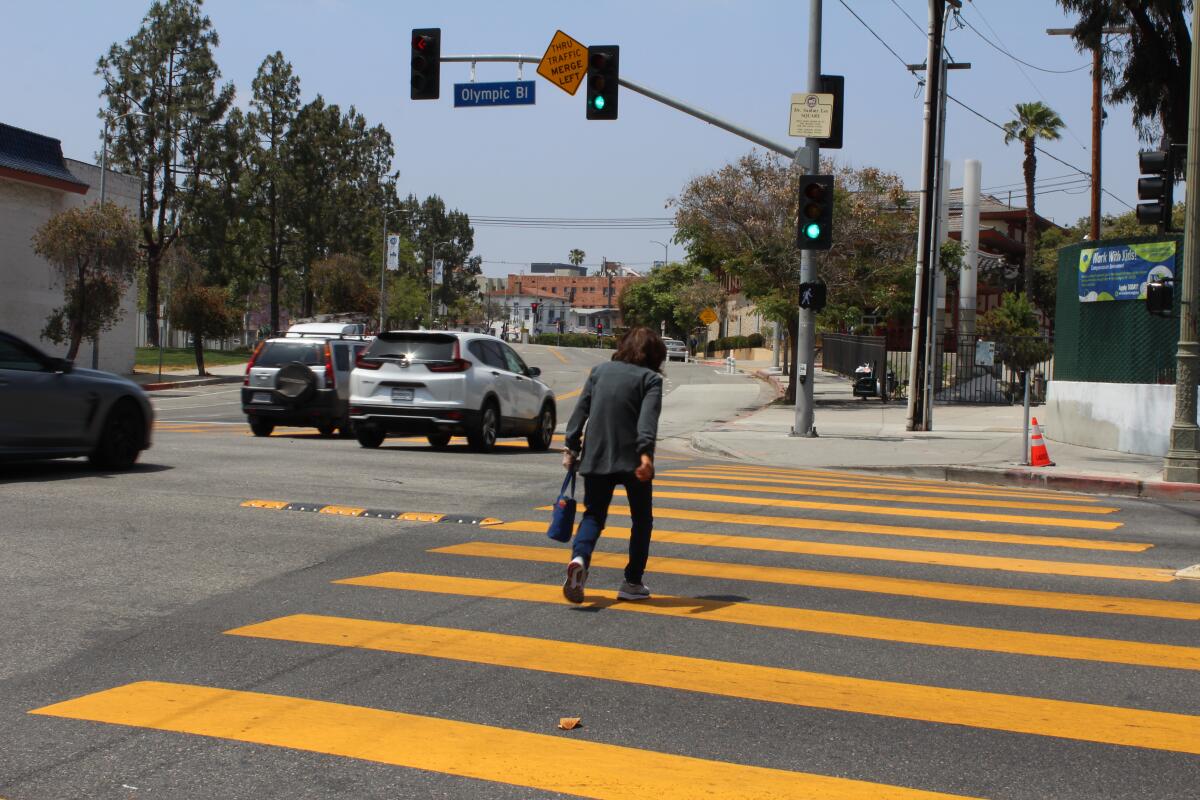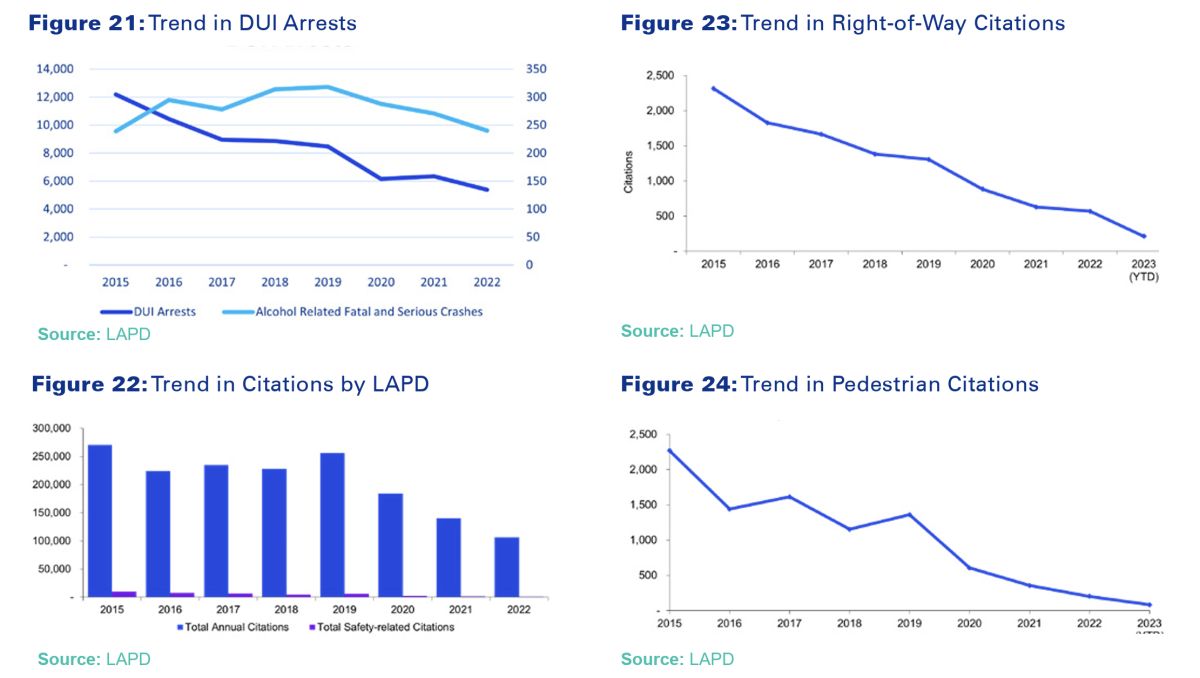An audit of L.A.’s program to fix deadly streets outlines its many failures

- Share via
Good morning. Here’s what you need to know to start your day.
- Los Angeles wanted to eliminate traffic deaths. Unfortunately, they rose.
- What is stopping Trump from exiling you to a foreign prison?
- Three simple and sunny hikes to do with family this weekend.
- And here’s today’s e-newspaper.
You're reading the Essential California newsletter
The most important California stories and recommendations in your inbox every morning.
You may occasionally receive promotional content from the Los Angeles Times.
How not to make streets safer
Nearly a decade ago, Los Angeles leaders launched Vision Zero, a program that aimed to eliminate traffic deaths on city streets by 2025.
In the years since, the number of people killed in crashes has surged. From 2016 to 2023, the annual death toll rose nearly 29% overall, and pedestrian deaths jumped roughly 54%. Fatal crashes fell last year, but deaths have exceeded 300 in each of the last three years. Thousands more people are severely injured in crashes annually.
What went wrong?
City officials released a long-awaited audit of the program last week, which outlines myriad missteps that contributed to the failure. Those include a lack of political will from city leaders, poor coordination between departments tasked with improving safety and an absence of accountability to actually follow through on projects and goals.
“Insufficient support from the Mayor’s Office and City Council Districts has at times limited the effectiveness of Vision Zero Program delivery,” the audit states. “The level of oversight of the Vision Zero initiative diminished over time and so has the level of enthusiasm at City Hall.”

For me and others who’ve been reporting on L.A.’s deadly streets over the last decade, this is no revelation. It’s what I’ve heard multiple times from city officials, safety experts and community advocates. Still, the audit is a public record of L.A. leaders’ failure to follow through on the city’s goal to save lives, even as they insist that public safety is their top priority.
And that failure has real victims. In the years since L.A. adopted the Vision Zero framework, more than 2,800 people have been killed in crashes on city streets.
A moonshot that mostly failed to launch
In August 2015, then-Mayor Eric Garcetti issued an executive order to launch L.A.’s Vision Zero program, adopting an international safety framework that aims to reduce and ultimately eliminate traffic fatalities. In the years that followed, the city’s Department of Transportation identified dozens of dangerous streets and intersections that would be targeted for safety upgrades, including improved pedestrian crossings, bike lanes and speed feedback signs.
The basic philosophy: traffic deaths are not unavoidable accidents but the result of longstanding policy and design failures that prioritize car speed over safety. Proponents say the key is to reengineer streets so that drivers are compelled to slow down and pay more attention to pedestrians, cyclists and other road users.
At the time, city officials compared the ambitious program to President Kennedy’s goal of putting a man on the moon. Based on the audit findings, L.A. leaders have struggled to get off the launch pad.
What did the audit find?
Definitely too much to get into all the detail here, but there are some key takeaways.
The 130-page independent audit was conducted by the firm KPMG, contracted by L.A.’s Office of the City Administrator. Among the findings:
- Auditors identified 56 key “actions and strategies” targeted for completion by either 2017 or 2020. At the end of 2023, nearly half had not been completed.
- There were “no program policies, procedures, and governance frameworks to guide program staff and other involved parties” tasked with planning, building and managing Vision Zero projects.
- Some projects may involve multiple city departments, but did not assign a lead agency, “resulting in a lack of accountability.”
- Police enforcement of traffic safety is considered vital in the current system of accountability for road users, but Los Angeles Police Department’s participation in Vision Zero “has diminished over time,” the audit states.
The audit points to several reasons for the lack of results, including the pandemic, “conflicts of personality, lack of total buy-in for implementation, disagreements over how the program should be administered” and trouble adding safety upgrades at scale.

‘A piece of paper is not a program’
Mike Bonin, a former L.A. City Council member, says the state of L.A.’s deadly streets is not an indictment of Vision Zero, but proof that city leaders failed to meaningfully put the policy into pavement.
“We approved the policy, but we haven’t implemented it,” he told me earlier this year. “A piece of paper is not a program … all we’ve done, for the most part, is left it as a piece of paper.”
Bonin represented westside neighborhoods in Council District 11 from 2013 to 2022 and was one of the city’s more vocal Vision Zero advocates.
Some local road redesigns Bonin pushed for sparked intense backlash from angry drivers, leading to lawsuits and an attempt to recall him from office. Some of the road changes were later reversed.

Bonin chalked up the vehement opposition to a lack of public perception of traffic killings as a true crisis, as well as a car-centric culture that prioritizes fast driving, and social hypocrisy.
“Nobody wants people going fast through their neighborhood, but everybody wants to be able to go fast through everybody else’s neighborhood,” Bonin said. “We would have done a lot better if we had really defined the problem for the public a lot better.”
For Damian Kevitt, executive director of Streets Are For Everyone, the Vision Zero audit supported his claim that L.A. leaders “doomed this program to a symbolic trash heap.”
In addition to thousands of deaths and serious injuries, “the city has had to pay out tens, if not hundreds of millions of dollars in lawsuits in the last 10 years,” Kevitt said.
“Despite this harsh report, the ignorance and lack of care continue,” he added.
What’s next?
The report’s authors outlined several recommendations to improve the program, including actually spending the money allocated to it.
For instance, Vision Zero received $35.8 million for the 2022-23 fiscal year, but “a substantial portion” of those funds had not been spent as of December 2023, the audit found.
Among the recommendations:
- Actually put someone in charge of the program by establishing a “dedicated program management unit.”
- Restart the program task force that had multiple department leaders coordinating Vision Zero actions. The task force stopped meeting in 2018.
- Support safety initiatives such as the in-progress speed camera pilot program and consider readopting red light cameras.
Elsewhere in the world — and in some U.S. cities — Vision Zero and similar strategies have helped reduce crashes and save lives. But progress depends on a multitude of factors, including political will, driver accountability, public outreach and stronger safety regulations for automakers.
This year, LAPD data show that 62 people have been killed in traffic crashes as of April 5. More than half of those victims were pedestrians killed by drivers. Nearly 400 other people were seriously injured in crashes during that time period.
Today’s top stories

What is stopping President Trump from exiling you to a foreign prison?
- If the Trump administration is willing to deny due process to noncitizens — against direct court orders to reverse course — what is preventing it from doing the same to U.S. citizens?
- More immigrants are opting to self-deport rather than risk being marched out like criminals.
- An international student at UCLA was detained at U.S.-Mexico border. Since late March, the Trump administration has suddenly canceled more than 1,000 visas of foreign students in the U.S.
A U.S.-China trade war threatens to upend not only the American economy but the global order
- An extreme, protracted trade war between the two global superpowers brings profound risk that, economists say, could destabilize the world economy, trigger a global recession and plunge millions into poverty.
- It also could transform the balance of global power in ways that fundamentally undermine standing of the U.S. in the world.
- Meanwhile, tariffs are tormenting contractors and developers, casting a cloud over L.A.’s efforts to rebuild after the fires.
Everything you need to know about Disneyland’s biggest event of the decade
- The Disneyland Resort is turning 70 in July, and is celebrating with a party that starts May 16 and is planned to last through summer 2026.
- Here’s everything you need to know about the Disneyland Resort 70th Celebration — including details on a ticket deal.
What else is going on
- The slaying of a 13-year-old boy has devastated an L.A. immigrant community.
- Southern California home price growth is slowing. Whose market is it now?
- A live colossal squid, the super-heavyweight of the deep sea, was caught on video for the first time.
- This professor studies dictatorships. He helped convince Harvard to stand up to Trump.
- Disney’s theme parks are its economic engine. Tariffs could put a damper on it.
- Plagued with pollution for decades, Tijuana River is ranked the nation’s second-most endangered.
- The Menendez brothers face a key hearing in their bid for freedom as L.A. County Dist. Atty. Nathan Hochman seeks a delay.
Get unlimited access to the Los Angeles Times. Subscribe here.
Commentary and opinions
- In 2013, a wildfire tore through Yosemite National Park. Its slow recovery can teach Angelenos what to expect in the wake of the Eaton and Palisades fires of 2025, the Times’ Corinne Purtill writes.
- Is the U.S. facing a constitutional crisis? The answer, unequivocally and emphatically, is yes. But it also could get much worse, warns guest columnist Erwin Chemerinsky.
This morning’s must reads

Don’t call it Pilates. Inside the exercise trend that’s like ‘if Pilates and bodybuilding had a baby.’ About 50 Southern California studios currently license rights to use Lagree equipment, many of which are in Los Angeles. You might think it’s harder Pilates. But its creator Sebastien Lagree would say you’re wrong.
Other must reads
- In the Coachella Valley, a team of middle school girls is helping keep escaramuza alive.
- Inside the delightful Pasadena Showcase House of Design, where maximalism is in.
How can we make this newsletter more useful? Send comments to [email protected].
For your downtime

Going out
- The Lyrid meteor shower creates a light show for Earth Day. Here’s how to get the best view.
- 👻 Halloween Horror Nights without the horrors? Welcome to Universal Studio’s new Fan Fest.
- 🥾 Three simple and sunny hikes to do with family this weekend.
- 🏋🏽♀️ L.A. Circuit: The best places to exercise in the city.
Staying in
- 📺 Ramy Youssef’s new Prime Video animated sitcom, “#1 Happy Family USA,” looks at 9/11 through a Muslim American kid’s lens.
- 📚 These are the 21 best new cookbooks of spring 2025.
- 🍽️ Here’s a recipe for scallops with espelette butter.
- ✏️ Get our free daily crossword puzzle, sudoku, word search and arcade games.
A question for you: What is the best concert or music festival you experienced in California?
Roberta Soules writes: “Ray Charles at the Long Beach Municipal Auditorium — a beautiful old building at the beach which was torn down in 1975. The entire audience was rocking and dancing.”
Email us at [email protected], and your response might appear in the newsletter this week.
And finally ... your photo of the day
Show us your favorite place in California! Send us photos you have taken of spots in California that are special — natural or human-made — and tell us why they’re important to you.
Today’s great photo is from contributor Pele Joez as part of a story from The Times’ Kailyn Brown about L.A.’s Black indoor roller-skating scene.
Have a great day, from the Essential California team
Ryan Fonseca, reporter
Andrew Campa, Sunday reporter
Kevinisha Walker, multiplatform editor
Christian Orozco, assistant editor
Karim Doumar, head of newsletters
Check our top stories, topics and the latest articles on latimes.com.
Sign up for Essential California
The most important California stories and recommendations in your inbox every morning.
You may occasionally receive promotional content from the Los Angeles Times.





